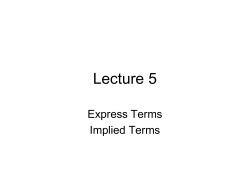
Homework #3 Econ 435 Fall 2014 Prof. Eschker
Homework #3 Econ 435 Fall 2014 Prof. Eschker Due Wednesday, October 15 at the start of class Turn in answers ONLY, not the questions. Show your work. 1. a. You are hiring an employee, and you advertise the position for $30,000. If someone offers to work for $25,000, should you hire her? b. Suppose you are going to lend $1,000 at 5% interest, and someone offers to pay 10% interest. Should you take the offer? 2. Consider a variation of the example of adverse selection we did in class. The safe firm undertakes the safe project, which earns $12,000 all the time. The risky firm undertakes the risky project, which earns $22,000 ½ of the time and $0 ½ of the time. Suppose that a bank is willing to lend but it needs to get repaid $10,000 on average if the project is successful. In other words, the bank sets the payment if successful according to the following: $10,000 = (probability of success) * (payment if successful) a. If the bank knows which firm is safe, how much payment will the bank want from the safe firm if the project is successful? Will the safe firm be able to pay this? b. If the bank knows which firm is risky, how much payment will the bank want from the risky firm if the project is successful? Will the risky firm be able to pay this? c. If the firm can’t tell which firm is risky and which is safe (asymmetric information), then what is the probability of success it assumes for each firm? Using this probability of success, how much payment will the bank want from each firm? d. Will the safe firm pay this? Will the risky? e. With asymmetric information, which firms are left taking out loans, and are there any firms that will agree to the loan payment if successful? 3. Consider a variation of the collateral example we did in class. Suppose that a safe project earns $1,500 and a risky project earns $2,000 half of the time and $0 half of the time. Suppose that the firm borrows to fund the project, and that the bank needs to be repaid $1,200 for the loan. If the project earns $0, then the firm defaults on the payment. a. How much does the firm get to keep, after repaying the loan, if it chooses the safe project? How much does the bank get? b. How much does the firm get to keep, after repaying the loan, if it chooses the risky project? How much does the bank get? Hint: you need to calculate expected payment = (Probability of Success)*(Payment if successful) + (Probability of default)*(Payment if default) c. Does the firm prefer the risky or safe project? What does the bank prefer? d. What is the smallest level of collateral the causes the firm to choose the safe project? Recall that collateral lowers expected payment if there is default, since the bank takes collateral from the firm. With collateral, Expected payment = ½*800 + ½*(-collateral) . Hint: What level of collateral gives the same expected amount to the firm as calculated in part a)? 4. Suppose that Fang’s Bank purchases Alexei’s Bank, making Alexei a subsidiary of Fang. Does this acquisition benefit the stockholders of Fang’s Bank? Does the answer depend on the motives for the purchase? Explain. (Hint: Review the motives for bank consolidation discussed in Section 8.2.) 5. Securitization has spread from mortgages to student loans and credit card debt. However, few loans to businesses have been securitized. Explain why.
© Copyright 2025





















